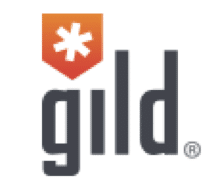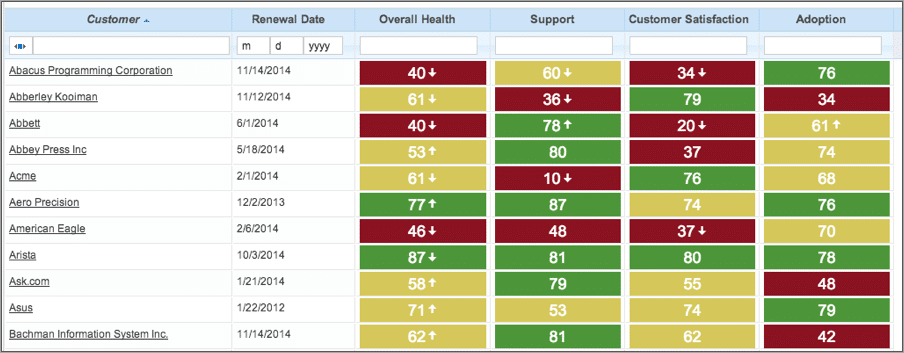How Gild Dropped Monthly Churn From 4% to <1%

Gild is helping companies better recruit engineers, by using data available on the web (including developers’ actual code) to help measure their abilities.
Brad Warga is the SVP Customer Success there. While Gild’s more than 50 people now, Brad joined when there were just 5 people: CEO, CTO, CSO, head of sales & head of marketing. (They invested in Customer Success early.)
Brad had been in HR/recruiting for 20 years, including recently being the VP Corporate Recruiting at Salesforce.com, helping organize & execute thousands of hires.
The team wasn’t exactly sure what Brad would do at first, but they felt he could bring a lot of credibility, and he did. First, he helped bring in new customers.
Gild’s “First 50 Customers” Sales Process
- A lead came in (usually through word of mouth or relationships).
- Sales would qualify & demo it.
- When deal was about to close, Brad or the CEO would help close it.

This “relationship selling” worked to a certain point, up to about 50 customers, but they
needed to design Brad and the CEO out of the sales process to both enable faster growth and free Brad up to work on current customers.
And in the first year, Gild felt like they were doing really well – they barely lost any customers. But everyone was on annual contract…and after the first year of selling, as contracts came up for renewal, churn leaped to 3-4% per month (>30% per year); 2-3x higher than their goals.
Churn Goals: “15% & 0%”
A rule of thumb is that a Saas company ideally has:
1. 15% or less churn per year on their total number of customers, and
2. 0% or negative revenue churn (expansion/upsell revenue from ongoing customers should exceed revenue lost from leaving customers).
So – Gild at this point had two challenges:
First Challenge: “How can sales close deals on their own?”
Gild made their sales process independent of Brad and the CEO with a) a lot of training & knowledge transfer to the sales team, plus b) hiring a different caliber of salesperson who was more solution oriented/consultative.
Second Challenge: ”How can Brad build a customer team to systematize success?”
Again, Brad couldn’t be the bottleneck relying on his relationships. Gild starting measuring and analyzing churn, and realized many of their assumptions were wrong, like that the frequency of users logging in mattered.
It turned out that how often people logged in wasn’t the best way to tell who would stay or go. Gild actually needed to look at which parts of the product were being used, and how. How savvy were the users? What were their recruiting needs and methods?
By digging into these root causes of churn, Brad & Gild were able to systematize customer success. (And – it made Gild much smarter about targeting the right kinds of customers from the very beginning with lead generation.)
Gild’s Main Three Customer Success Methods:
- 90 Day Adoption
- Quarterly Business Reviews
- Predictive Tools
1. The First 90 Days
The Customer Success team’s relationship with a customer starts when the customer purchases the product and it’s turned on. The team trains the new users how to use the product, and even what the best recruiting practices are.
The customer success team also re-sells the customer users on why Gild was created and how it can help with their pains, to give them context and help them get excited about the tool. Just because a decision maker was excited doesn’t mean their users will be!
Gild’s found out that if there’s successful usage of the product in the first 90 days, then usage will be 3x higher for the rest of the year than a customer who didn’t adopt fast. So a big investment in training and services upfront pays big dividends later and in renewals.
Don’t Ignore Your Users: Now more than ever it’s the users who decide whether to renew a product or not. As a renewal comes up, decision makers will ask the team “Do you use this product? Get value from it? Should we use it another year?”
The team can track everything being done to the system, so that they can help ensure customers are doing their best, say when a user misspells a word in a search box. The Customer Success team can initiate a chat with a user to guide them if they when customers make mistakes in the system or enter the wrong data.
2. Quarterly Business Reviews
These “reviews” are primarily to help hold the customer accountable to what they signed up for. These are formal meetings, and ideally onsite with the best customers. Because users know the meetings will happen and executives will review their progress, it helps gives users something to work towards in showing off their success.
3. Using Predictive Tools
Gild’s main Customer Success tool is Gainsight, along with Zendesk (to capture trouble tickets and feature requests), Salesforce.com and Olark (chat).
Gild uses these tools to identify & track three segments of customers, based on the size of account, their potential growth and how easily their 90 Day Adoption went.
Team Composition
The Gild Customer Success (“CS”) team has about 10 people across three roles (yes out of 50 employees!):
1) An Inside CS team: a team of four who sit in Salt Lake City. This team handles all the training, monitor usage, analytics, marketing updates, and works remotely with customers through phone and video. They’ve found one inside CS rep can handle about 70 users effectively.
2) An Outside CS team of “Senior Customer Success Associates,” who are tasked and measured on renewals. There are about one of these reps per 30 users in the “middle customer segment”.
3) An Executive CS team of four field CS reps serving bigger customers and responsible for upselling (with quotas).
Main Apps Used
As mentioned above, the four main apps used are Gainsight, Salesforce.com, Zendesk (to track customer service issues & feature requests), and Olark (chat – mostly used by the inside CS team).
Gainsight is the main app and user interface, with the data from the others (Zendesk / Salesforce.com / Olark) being presented through Gainsight so it’s all in one interface for reps.
By using Gainsight and getting a sense of what’s going right or wrong at a customer, it gives reps a great reason to call and talk about either improving usage or buying extra licenses or product, and Gild can create dashboards such as this one:
Hiring Profile for CSMs
Gild’s found success in hiring anyone who’s upbeat, smart and has some service experience – and the rest they can learn on the job. So it’s been easy to hire well.
Making Customer Success C-Level
A lot of companies treat customer success as an afterthought, or glorified customer support. Companies need to treat it (at least) as important as sales or marketing.
To do that, Customer Success needs to define exactly how it contributes. At Gild, Customer Success owns:
- 90 Day Adoption
- Feeding usage data & customer feedback into the product roadmap
- Renewals
- Upsells
By owning these and being able to clearly articulate them, it’s easy for the board to recognize the value of Customer Success there.
